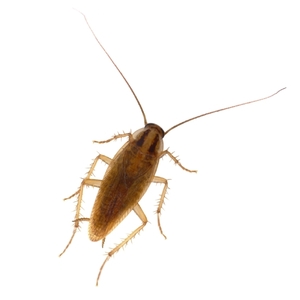
The German cockroach is by far the most important and common cockroaches found in houses, apartments, supermarkets, food plants and restaurants. It has a great adaptability and enormous reproductive potential. It is worldwide in distribution. Anyone could find cockroaches at home because they are often introduced by packaging of food we bring back home. It would be bad luck. An infestation however is caused by poor sanitation or conducive human behavior allowing cockroaches to reproduce and multiply.
Preparation Guidelines (What to do before treatment)
- Repair any water leak. Advise management of any repairs that need to be done.
- Empty your kitchen pantry and cabinets. Discard infested or stale food items in a sealed plastic bag. Make
sure your food is stored in sealed or tight containers.
- Empty your bathroom cabinets.
- Clean and remove all organic matter and grease, including inside all the cabinets and behind your refrigerator
and oven.
- Remove all furniture from the walls.
- Do not use any other insecticide.
- Leave a note on the kitchen table with your observations of cockroaches, it may help us.
- You must leave your apartment for the treatment for 1 to 2 hours. Bring all pets with you.
Identification
- Nymphs: 2-12mm
- Adults: 13-16mm
- Ootheca (egg capsule): 6-9mm
- Adult Color: light brown to yellow with the exception of two black stripes on pronotal shield
- Adults have wings.
Signs of infestation
- Feces or other secretions (grains or brown spots)
- Cockroaches or egg capsules
- The musty odor in a severe infestation
- Exuviae (empty skin left behind after molting)
- Cockroaches are nocturnal so if you see them in daytime, there is probably a major infestation or they are under stress such as scarcity of food or the use of repellent products.
Biology
Reproduction
- A single mating can be sufficient to fertilize all eggs produced by one female.
- The female will lay about 5 oothecas (egg capsules) in her lifetime.
- The female carries the egg case attached to her abdomen for about 28 days and deposits it in a crack 1 to 2 days before hatching.
Ootheca
- The ootheca is a capsule containing the eggs of the cockroach.
- Brown, pink or beige but usually in two tones.
- The ootheca contains about 30-40 eggs.
Lifecycle
- From egg to adult: Approximately 100 days. In lab conditions: 50-60 days (27 ° C, 40% RH).
- 6 nymphal stages before becoming adults.
- Once hatched, the cockroach reaches maturity in about 60 days.
- The adult lives in general for 100 to 200 days.
Habits
- Cockroaches have a preference for the dark, warm (over 21 ° C) and humid places.
- They are mainly found in kitchens and bathrooms. Water is essential to their survival.
- The cracks and crevices near a source of food or water are preferred hiding places.
- Cockroaches eat almost anything with nutritive value including even soap, glue, toothpaste, hair, etc.
- They are most often introduced into buildings through packaging or products purchased in grocery stores or used equipment such as refrigerator, TV, microwave oven, etc.
- They sometimes move from one apartment to another to satisfy their basic needs or in response to the application of a repellent.
- They spend about 75% of their time in hiding spots.
- Cockroaches are mainly nocturnal.
Prevention
- Inspect the grocery packaging, bags and products you bring back home.
- Avoid introducing furniture or supply if you are unsure of their presence.
- Repair water leaks or excessive moisture.
- Seal cracks and crevices and avoid cluttering.
- Do not leave dirty dishes lying around or food.
- Degrease the walls, cabinets and appliances occasionally.
- Use sticky traps to detect the presence of cockroaches.
- Avoid repellents when their presence is confirmed.
Health Risks
- Besides being a nuisance because they tend to visit garbage cans, sewers and other places full of diseases, germs attach to the body of the cockroach and can be spread to food, surfaces and cooking gear with whom they come into contact. These include bacteria: Salmonella, Shigella, E. coli, Streptococcus (pneumonia), several helminths (parasitic worms), and even viruses such as polio. Cockroaches can also transmit various forms of gastroenteritis (food poisoning, dysentery, diarrhea and other diseases)
- Their feces and exuviae cause allergies and respiratory problems.
- Repeated exposure to insecticides if multiple treatments.

 Skip site navigation
Skip site navigation

